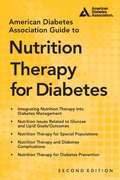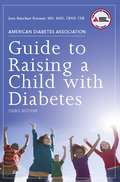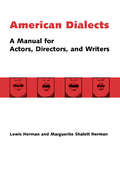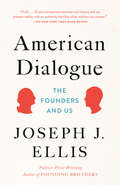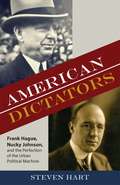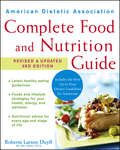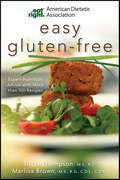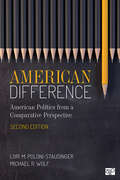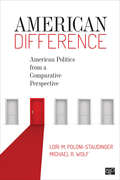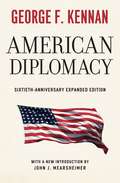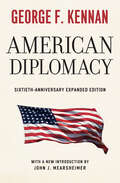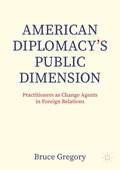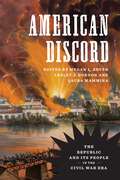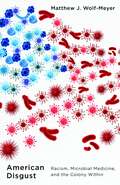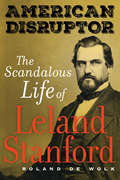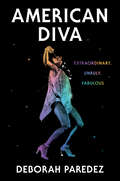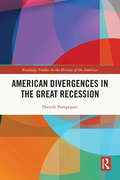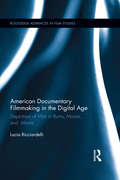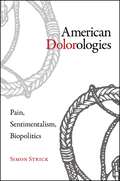- Table View
- List View
American Diabetes Association Guide to Nutrition Therapy for Diabetes
by Marion J. Franz Alison EvertDiabetes greatly affects how people's bodies manage the food they eat. It is essential that people with diabetes follow a carefully structured meal plan and learn specific skills in order to better control their blood glucose levels. The tactics for helping people manage their diabetes through how they eat is called medical nutrition therapy (MNT).Here the American Diabetes Association presents all of the key information and strategies for effectively teaching patients how to manage their diets. Drawing on the knowledge and expertise of dozens of experts in the field, this book covers all of the key topics for implementing successful medical nutrition therapy.Topics include:Thorough discussion of nutrientsDescription of MNT for type 1 and type 2 diabetesDiscussion of providing MNT to special populations, including youth and older individualsExplanation of the different complications of diabetes, such as kidney disease, celiac disease, and cystic fibrosis, and how they impact MNTLatest details on new technology used in MNTGuidelines and strategies for teaching patients about nutrition therapy and how to use it in their daily livesUsing MNT to help prevent diabetes
American Diabetes Association Guide to Raising a Child with Diabetes
by Jean Betschart RoemerThe American Diabetes Association Guide to Raising a Child with Diabetes, 3rd edition features the latest advances in diabetes care to help your child have a healthy active childhood. Full of problem-solving examples and easy-to-use tables, you will learn how:To adjust insulin to allow for the foods kids love to eatTo help the child with type 2 diabetesTo plan meals that are nutritious and balancedTo play sports and games safelyTo handle sick daysYour child can maintain a busy schedule and still feel healthy and strongTo negotiate the twists and turns of being "different"To accept the physical and emotional challenges that life has to offerAnd much more
American Dialects: A Manual for Actors, Directors, and Writers
by Lewis Herman Marguerite Shalett HermanThis standard text, now in paperback for the first time-- the companion volume to Foreign Dialects-- American Dialects offers representative dialects of every major section of the United States. In each case, a general description and history of the dialect is given, followed by an analysis of vowel and consonant peculiarities, of its individual lilt and rhythm, and of its grammar variations. There are also lists of the idioms and idiomatic expressions that distinguish each dialect and exercises using them. American Dialects also includes musical inflection charts and diagrams showing the placement of lips, tongue, and breath.
American Dialogue: The Founders and Us
by Joseph J. EllisThe award-winning author of Founding Brothers and The Quartet now gives us a deeply insightful examination of the relevance of the views of George Washington, Thomas Jefferson, James Madison, and John Adams to some of the most divisive issues in America today. <p><p> The story of history is a ceaseless conversation between past and present, and in American Dialogue Joseph J. Ellis focuses the conversation on the often-asked question "What would the Founding Fathers think?" He examines four of our most seminal historical figures through the prism of particular topics, using the perspective of the present to shed light on their views and, in turn, to make clear how their now centuries-old ideas illuminate the disturbing impasse of today's political conflicts. He discusses Jefferson and the issue of racism, Adams and the specter of economic inequality, Washington and American imperialism, Madison and the doctrine of original intent. Through these juxtapositions--and in his hallmark dramatic and compelling narrative voice--Ellis illuminates the obstacles and pitfalls paralyzing contemporary discussions of these fundamentally important issues.
American Dictators: Frank Hague, Nucky Johnson, and the Perfection of the Urban Political Machine (Rivergate Regionals Collection)
by Steven HartAmerican Dictators is the dual biography of two of America's greatest political bosses: Frank Hague and Enoch "Nucky" Johnson. The book shows Hague and Johnson at the peak of their power and the strength of their political machines during the years of Prohibition and the Great Depression. Steven Hart describes how both men used their influence to benefit and punish the local citizenry, amass huge personal fortunes, and sometimes collaborate to trounce their enemies.
American Diet Revolution!: The Strength for Life Guide to the Foods We Must and Must Not Eat To Be Leaner and Stronger in the 21st Century
by Dr. Josef ArnouldA nutrition expert examines why Americans have been eating poorly and offers easy, money-saving ways to eat better, healthier, more nutritious foods. Obesity, diabetes, dementia, and related epidemics plaguing Americans today are primarily the result of deceptive dietary advice that began in the 1950s. By following that advice faithfully throughout the last half of the twentieth century, most Americans became helpless victims of these diseases. Now, in American Diet Revolution!, Dr. Josef Arnould reveals how Americans can throw off the chains of that 1950s dietary advice, overcome these epidemics, and regain the personal freedom of good health. He conveys why Americans must eliminate the fattening, inflaming, toxic, industrial foodstuffs that have dominated their diets for decades and how they can easily do so. Additionally, American Diet Revolution! shares simple and economical strategies to purchase and prepare nutritious foods to replace the toxic ones of the past. Then, in an empowering finale, Dr. Arnould takes the genre of dietary advice to a new place and demonstrates that, by rejecting the deceitful dietary advice of yesteryear, Americans are inciting a second American Revolution. In the process of creating new diets and new food economics based upon honest nutritional research, Americans are revolting peacefully, but powerfully, against all individuals and organizations that previously maximized their power and profits by colonizing Americans with toxic information, toxic foods, and toxic drugs.
American Dietetic Association Complete Food and Nutrition Guide
by Duyff Roberta Larson Null* Latest healthy eating guidelines * Foods and strategies for your good health * Nutritional advice for every age and stage of life A lifetime of sound, easy, and positive advice on healthy eating'from the world's foremost authority on food and nutrition The choices you make every day about food, nutrition, and health can have a major impact on your life. To find the most reliable nutrition information and sound advice in achieving optimal health, look no further. This comprehensive book from the American Dietetic Association explains everything you need to know about eating healthy, with simple, practical tips and flexible guidelines designed to help you choose nutritious, flavorful, and fun foods to suit your needs and lifestyle at any age. This brand-new edition of the bestselling American Dietetic Association Complete Food and Nutrition Guide offers the most up-to-date nutrition information for the whole family. From the healthiest baby food to eating well in the golden years, this fully revised, quick-access guide features: * New chapters on the use and abuse of supplements (including herbals and other botanicals) and on nutrition and health conditions (including Syndrome X and adult and childhood diabetes) and food-drug interactions * An expanded chapter on women's health and nutrition that covers breast cancer, fibromyalgia, and the link between folic acid and heart disease * The latest on food-borne bacteria and ways to prevent food-borne illness * Help for making the right food choices in restaurants * Facts about functional foods and phytonutrients for health, and nutritious ethnic food choices * What you need to know about food and water safety * American Heart Association, USDA, and American Cancer Society guidelines, as well as the DASH "blood-pressure-lowering" diet * Up-to-date information on food labeling and food allergens and intolerances, including celiac disease * More on managing body weight, the truth about today's popular diets, and controlling emotional overeating * Ways to blend nutrition with great taste'in fun, easy ways * And much more
American Dietetic Association Complete Food and Nutrition Guide, 3rd Edition
by Roberta Larson DuyffWith over 200,000 copies sold in all editions, this award-winning resource from the world's leading authority on food and nutrition is packed with the latest healthy eating advice for those at every age and stage of life. In this completely revised and updated new edition, you'll find up-to-date, evidence-based, practical answers for your many food and nutrition questions. This cornerstone guide from the American Dietetic Association, written by nationally recognized food and nutrition expert and registered dietitian Roberta Duyff, covers the basics on nutrition, managing weight, and healthy eating. It also provides easy steps and how-tos for selecting, preparing, and storing foods safely to get the most nutrition and flavor for your dollar, and more. Comprehensive, accessible, and easy-to-use, this valuable reference shows how to make healthy food choices to fit any lifestyle. How to put the the very latest Dietary Guidelines for Americans on food choices and physical activity into action Latest guidance to prevent and manage today's health concerns, such as heart disease, diabetes, cancer, food allergies, gluten intolerance, lactose intolerance, and many others Simple, practical tips and flexible food and nutrition skills that suit your needs and lifestyle with ways to apply advice from USDA's MyPlate Advice for healthy nutrition, eating, and cooking across the lifespan Covers vegetarian eating, healthy restaurant options, culinary nutrition and skills, healthy weight, nutrition supplements, and more Interactive self-checks and websites to help you assess your own food choices and take steps to healthy eating
American Dietetic Association Easy Gluten-Free: Expert Nutrition Advice with More than 100 Recipes (American Dietetic Association Ser.)
by Shauna James Ahern Tricia Thompson Marlisa BrownFrom the ADA-the complete guide to a healthy gluten-free dietHave you or a family member been diagnosed with celiac disease or non-celiac gluten sensitivity? Are you worried that "gluten-free" means boring, bland, and lacking in nutrition? Worry no more. This book will show you how to bring the benefits of delicious, gluten-free whole grains back into your diet and whip up delicious dishes you'll be proud to share with family and friends. From the foremost authority on nutrition, ADA Easy Gluten-Free arms you with cutting-edge information and easy-to-follow recipes to develop healthy gluten-free meals packed with flavor and variety. Learn about the plethora of gluten-free whole grains: how to select them, cook them, and use them in all your meals and snacks Browse more than 130 nutritious and delicious gluten-free recipes for any of your dining needs, from starters and main courses to sides, breads, and desserts Try simple and tempting dishes such as Sweet Potato Quesadillas , Quinoa with Roasted Garlic and Shrimp, Oatmeal Pear Spice Muffins , and Chocolate Sponge Cake with Chocolate Glaze Learn the basics of healthy gluten-free nutrition, choosing gluten-free ingredients, reading labels, and much more Start with four easy weeks of gluten-free meal plans to help you jumpstart and maintain a healthy gluten-free lifestyle Find easy-to-follow information on how to on how to choose and use tasty gluten-free whole grains, from brown rice and oats to millet, teff, and sorghumSo many quick and easy dishes and creative recipes make the book a must for any culinary library.
American Difference: A Guide to American Politics in Comparative Perspective
by Michael R. Wolf Lori M. Poloni-StaudingerExamining democracies from a comparative perspective helps us better understand why politics—or, as Harold Lasswell famously said, "who gets what, when, and how"—differ among democracies. American Difference: A Guide to American Politics in Comparative Perspective takes the reader through different aspects of democracy—political culture, institutions, interest groups, political parties, and elections—and, unlike other works, explores how the United States is both different from and similar to other democracies. The fully updated Second Edition has been expanded to include several new chapters and discussion on civil liberties and civil rights, constitutional arrangements, elections and electoral institutions, and electoral behavior. This edition also includes data around the 2016 general election and 2018 midterm election.
American Difference: A Guide to American Politics in Comparative Perspective
by Michael R. Wolf Lori M. Poloni-StaudingerExamining democracies from a comparative perspective helps us better understand why politics—or, as Harold Lasswell famously said, "who gets what, when, and how"—differ among democracies. American Difference: A Guide to American Politics in Comparative Perspective takes the reader through different aspects of democracy—political culture, institutions, interest groups, political parties, and elections—and, unlike other works, explores how the United States is both different from and similar to other democracies. The fully updated Second Edition has been expanded to include several new chapters and discussion on civil liberties and civil rights, constitutional arrangements, elections and electoral institutions, and electoral behavior. This edition also includes data around the 2016 general election and 2018 midterm election.
American Difference: American Politics from a Comparative Perspective
by Dr Lori Poloni-Staudinger Michael R. WolfExamining democracies from a comparative perspective helps us better understand why politics—or “who gets what, when, and how”—differs among democracies. In American Difference: American Politics from a Comparative Perspective, authors Lori M. Poloni-Staudinger and Michael R. Wolf take the reader through different aspects of democracy—political culture, institutions, interest groups, political parties and elections—and explore how the US is both different from and similar to other democracies. Used in conjunction with a textbook for courses in Introduction to American Politics, Introduction to Comparative Politics, or Introduction to Politics, this book will provide additional context and deepen students’ understanding of key political concepts.
American Difference: American Politics from a Comparative Perspective
by Dr Lori Poloni-Staudinger Michael R. WolfExamining democracies from a comparative perspective helps us better understand why politics—or “who gets what, when, and how”—differs among democracies. In American Difference: American Politics from a Comparative Perspective, authors Lori M. Poloni-Staudinger and Michael R. Wolf take the reader through different aspects of democracy—political culture, institutions, interest groups, political parties and elections—and explore how the US is both different from and similar to other democracies. Used in conjunction with a textbook for courses in Introduction to American Politics, Introduction to Comparative Politics, or Introduction to Politics, this book will provide additional context and deepen students’ understanding of key political concepts.
American Dionysia
by Steven JohnstonViolence and tragedy riddle democracy - not due to fatal shortcomings or unnecessary failures, but because of its very design and success. To articulate this troubling claim, Steven Johnston explores the cruelty of democratic founding, the brutal use democracies make of citizens and animals during wartime, the ambiguous consequences of legislative action expressive of majority rule, and militant practices of citizenship required to deal with democracy's enemies. Democracy must take responsibility for its success: to rule in denial of violence merely replicates it. Johnston thus calls for the development of a tragic democratic politics and proposes institutional and civic responses to democracy's reign, including the reinvention of tragic festivals and holidays, a new breed of public memorials, and mandatory congressional reparations sessions. Theorizing the violent puzzle of democracy, Johnston addresses classic and contemporary political theory, films, little known monuments, the subversive music of Bruce Springsteen, and the potential of democratic violence by the people themselves.
American Diplomacy
by George F. KennanFor more than sixty years, George F. Kennan's American Diplomacy has been a standard work on American foreign policy. Drawing on his considerable diplomatic experience and expertise, Kennan offers an overview and critique of the foreign policy of an emerging great power whose claims to rightness often spill over into self-righteousness, whose ambitions conflict with power realities, whose judgmentalism precludes the interests of other states, and whose domestic politics frequently prevent prudent policies and result in overstretch. Keenly aware of the dangers of military intervention and the negative effects of domestic politics on foreign policy, Kennan identifies troubling inconsistencies in the areas between actions and ideals--even when the strategies in question turned out to be decided successes. In this expanded sixtieth-anniversary edition, a substantial new introduction by John J. Mearsheimer, one of America's leading political realists, provides new understandings of Kennan's work and explores its continued resonance. As America grapples with its new role as one power among many--rather than as the "indispensable nation" that sees "further into the future"--Kennan's perceptive analysis of the past is all the more relevant. Today, as then, the pressing issue of how to wield power with prudence and responsibility remains, and Kennan's cautions about the cost of hubris are still timely. Refreshingly candid, American Diplomacy cuts to the heart of policy issues that continue to be hotly debated today. "These celebrated lectures, delivered at the University of Chicago in 1950, were for many years the most widely read account of American diplomacy in the first half of the twentieth century. "--Foreign Affairs, Significant Books of the Last 75 Years
American Diplomacy: Sixtieth-anniversary Expanded Edition (Walgreen Foundation Lectures)
by George F. KennanFor more than sixty years, George F. Kennan’s American Diplomacy has been a standard work on American foreign policy. Drawing on his considerable diplomatic experience and expertise, Kennan offers an overview and critique of the foreign policy of an emerging great power whose claims to rightness often spill over into self-righteousness, whose ambitions conflict with power realities, whose judgmentalism precludes the interests of other states, and whose domestic politics frequently prevent prudent policies and result in overstretch. Keenly aware of the dangers of military intervention and the negative effects of domestic politics on foreign policy, Kennan identifies troubling inconsistencies in the areas between actions and ideals—even when the strategies in question turned out to be decided successes. In this expanded sixtieth-anniversary edition, a substantial new introduction by John J. Mearsheimer, one of America’s leading political realists, provides new understandings of Kennan’s work and explores its continued resonance. As America grapples with its new role as one power among many—rather than as the “indispensable nation” that sees “further into the future”—Kennan’s perceptive analysis of the past is all the more relevant. Today, as then, the pressing issue of how to wield power with prudence and responsibility remains, and Kennan’s cautions about the cost of hubris are still timely. Refreshingly candid, American Diplomacy cuts to the heart of policy issues that continue to be hotly debated today. “These celebrated lectures, delivered at the University of Chicago in 1950, were for many years the most widely read account of American diplomacy in the first half of the twentieth century.”—Foreign Affairs, Significant Books of the Last 75 Years
American Diplomacy’s Public Dimension: Practitioners as Change Agents in Foreign Relations (Palgrave Macmillan Series in Global Public Diplomacy)
by Bruce GregoryThis is the first book to frame U.S. public diplomacy in the broad sweep of American diplomatic practice from the early colonial period to the present. It tells the story of how change agents in practitioner communities – foreign service officers, cultural diplomats, broadcasters, citizens, soldiers, covert operatives, democratizers, and presidential aides – revolutionized traditional government-to-government diplomacy and moved diplomacy with the public into the mainstream. This deeply researched study bridges practice and multi-disciplinary scholarship. It challenges the common narrative that U.S. public diplomacy is a Cold War creation that was folded into the State Department in 1999 and briefly found new life after 9/11. It documents historical turning points, analyzes evolving patterns of practice, and examines societal drivers of an American way of diplomacy: a preference for hard power over soft power, episodic commitment to public diplomacy correlated with war and ambition, an information-dominant communication style, and American exceptionalism. It is an account of American diplomacy’s public dimension, the people who shaped it, and the socialization and digitalization that today extends diplomacy well beyond the confines of embassies and foreign ministries.
American Discord: The Republic and Its People in the Civil War Era
by John F. Marszalek Lawrence A. Kreiser Jr. Rob Hart Kevin Hughes T. Michael Parrish Adam Petty Charity Rakestraw Glenn Brasher Daniel Burge Katie Deale Will Greene Lindsey Privette Chris Teeters Christian McWhirterA panoramic collection of essays written by both established and emerging scholars, American Discord examines critical aspects of the Civil War era, including rhetoric and nationalism, politics and violence, gender, race, and religion. Beginning with an overview of the political culture of the 1860s, the collection reveals that most Americans entered the decade opposed to political compromise. Essays from Megan L. Bever, Glenn David Brasher, Lawrence A. Kreiser Jr., and Christian McWhirter discuss the rancorous political climate of the day and the sense of racial superiority woven into the political fabric of the era.Shifting focus to the actual war, Rachel K. Deale, Lindsay Rae Privette, Adam H. Petty, and A. Wilson Greene contribute essays on internal conflict, lack of compromise, and commitment to white supremacy. Here, contributors adopt a broad understanding of “battle,” considering environmental effects and the impact of the war after the battles were over. Essays by Laura Mammina and Charity Rakestraw and Kristopher A. Teters reveal that while the war blurred the boundaries, it ultimately prompted Americans to grasp for the familiar established hierarchies of gender and race.Examinations of chaos and internal division suggest that the political culture of Reconstruction was every bit as contentious as the war itself. Former Confederates decried the barbarity of their Yankee conquerors, while Republicans portrayed Democrats as backward rubes in need of civilizing. Essays by Kevin L. Hughes, Daniel J. Burge, T. Robert Hart, John F. Marszalek, and T. Michael Parrish highlight Americans’ continued reliance on hyperbolic rhetoric. American Discord embraces a multifaceted view of the Civil War and its aftermath, attempting to capture the complicated human experiences of the men and women caught in the conflict. These essays acknowledge that ordinary people and their experiences matter, and the dynamics among family members, friends, and enemies have far-reaching consequences.
American Disgust: Racism, Microbial Medicine, and the Colony Within
by Matthew J. Wolf-MeyerExamining the racial underpinnings of food, microbial medicine, and disgust in America American Disgust shows how perceptions of disgust and fears of contamination are rooted in the country&’s history of colonialism and racism. Drawing on colonial, corporate, and medical archives, Matthew J. Wolf-Meyer argues that microbial medicine is closely entwined with changing cultural experiences of digestion, excrement, and disgust that are inextricably tied to the creation of whiteness. Ranging from nineteenth-century colonial encounters with Native people to John Harvey Kellogg&’s ideas around civilization and bowel movements to mid-twentieth-century diet and parenting advice books, Wolf-Meyer analyzes how embedded racist histories of digestion and disgust permeate contemporary debates around fecal microbial transplants and other bacteriotherapeutic treatments for gastrointestinal disease. At its core, American Disgust wrestles with how changing cultural notions of digestion—what goes into the body and what comes out of it—create and impose racial categories motivated by feelings of disgust rooted in American settler-colonial racism. It shows how disgust is a changing, yet fundamental, aspect of American subjectivity and that engaging with it—personally, politically, and theoretically—opens up possibilities for conceptualizing health at the individual, societal, and planetary levels.
American Disruptor: The Scandalous Life of Leland Stanford
by Roland De WolkAmerican Disruptor is the untold story of Leland Stanford – from his birth in a backwoods bar to the founding of the world-class university that became and remains the nucleus of Silicon Valley. The life of this robber baron, politician, and historic influencer is the astonishing tale of how one supremely ambitious man became this country's original "disruptor" – reshaping industry and engineering one of the greatest raids on the public treasury for America’s transcontinental railroad, all while living more opulently than maharajas, kings, and emperors. It is also the saga of how Stanford, once a serial failure, overcame all obstacles to become one of America’s most powerful and wealthiest men, using his high elective office to enrich himself before losing the one thing that mattered most to him – his only child and son. Scandal and intrigue would follow Stanford through his life, and even after his death, when his widow was murdered in a Honolulu hotel – a crime quickly covered up by the almost stillborn university she had saved. Richly detailed and deeply researched, American Disruptor restores Leland Stanford’s rightful place as a revolutionary force and architect of modern America.
American Diva: Extraordinary, Unruly, Fabulous
by Deborah ParedezAn impassioned homage to the divas who shake up our world and transform it with their bold, dazzling artistry. What does it mean to be a “diva”? A shifting, increasingly loaded term, it has been used to both deride and celebrate charismatic and unapologetically fierce performers like Aretha Franklin, Divine, and the women of Labelle. In this brilliant, powerful blend of incisive criticism and electric memoir, Deborah Paredez—scholar, cultural critic, and lifelong diva devotee—unravels our enduring fascination with these icons and explores how divas have challenged American ideas about feminism, performance, and freedom. American Diva journeys into Tina Turner’s scintillating performances, Celia Cruz’s command of the male-dominated salsa world, the transcendent revival of Jomama Jones after a period of exile, and the unparalleled excellence of Venus and Serena Williams. Recounting how she and her mother endlessly watched Rita Moreno’s powerhouse portrayal of Anita in West Side Story and how she learned much about being bigger than life from her fabulous Tía Lucia, Paredez chronicles the celebrated and skilled performers who not only shaped her life but boldly expressed the aspiration for freedom among brown, Black, and gay communities. Paredez also traces the evolution of the diva through the decades, dismayed at the mid-aughts’ commodification and juvenilizing of its meaning but finding its lasting beauty and power. Filled with sharp insights and great heart, American Diva is a spirited tribute to the power of performance and the joys of fandom.
American Divergences in the Great Recession
by Daniele PompejanoGlobalization is quite different from internationalization: the by-now global market economy overwhelmed the sovereignty of the old national states. Close to the 2007 crisis, some de-coupling effects were consequent in most developed countries in comparison with the ex-Third World. Latin America seemed to entail a "divergence" with the First World, as unlike the past, it was not hit by the financial crisis, but old historical fragilities invalidated the short positive cycle produced by high international prices. This work deals with this crisis and its basic differences from the older crises of the Thirties and Seventies.
American Doctors in Canton: Modernization in China, 1835-1935
by Guangqiu XuTraditional Chinese medicine developed over thousands of years, but changes introduced from 1835-1935 by American missionary doctors initiated a landslide of cultural revolution in the city of Canton and medical modernization throughout China. Focusing on medical missionaries' ideas and approaches in a principal city of the period, Canton, Guangqiu Xu, a native of Canton, describes the long-term impact of American models of medical work, which are still in place in China today. Despite stiff resistance to change and Chinese suspicion of foreign ideas, the impact of American medical missionaries was profound. They opened medical schools, trained modern doctors, and promoted public health education. These transformations in turn led to major social movements in the modernization of Canton, such as the women's rights movement, modern charity and welfare systems, and modern hygiene campaigns. This book focuses on the changes American doctors brought to Canton, their implementation, what remains of their influence today, and how some of these transformations have spread across China. It shows that the Chinese have themselves become more responsive to cultural relations with the US as part of the acceptance of these changes, and demonstrates how the unique blend of modern Western and traditional Chinese medicines has helped modernize China and make Canton the cradle of modern reform and revolution in China.
American Documentary Filmmaking in the Digital Age: Depictions of War in Burns, Moore, and Morris (Routledge Advances in Film Studies)
by Lucia RicciardelliAmerican Documentary Filmmaking in the Digital Age examines the recent challenges to the conventions of realist documentary through the lens of war documentary films by Ken Burns, Michael Moore, and Errol Morris. During the twentieth century, the invention of new technologies of audiovisual representation such as cinema, television, video, and digital media have transformed the modes of historical narration and with it forced historians to assess the impact of new visual technologies on the construction of history. This book investigates the manner in which this contemporary Western "crisis" in historical narrative is produced by a larger epistemological shift in visual culture. Ricciardelli uses the theme of war as depicted in these directors’ films to focus her study and look at the model(s) of national identity that Burns, Morris, and Moore shape through their depictions of US military actions. She examines how postcolonial critiques of historicism and the advent of digitization have affected the narrative structure of documentary film and the shaping of historical consciousness through cinematic representation.
American Dolorologies: Pain, Sentimentalism, Biopolitics (SUNY Press Open Access)
by Simon StrickAmerican Dolorologies presents a theoretically sophisticated intervention into contemporary equations of subjectivity with trauma. Simon Strick argues against a universalism of pain and instead foregrounds the intimate relations of bodily affect with racial and gender politics. In concise and original readings of medical debates, abolitionist photography, Enlightenment philosophy, and contemporary representations of torture, Strick shows the crucial function that evocations of "bodies in pain" serve in the politicization of differences. This book provides a historical contextualization of contemporary ideas of suffering, sympathy, and compassion, thus establishing an embodied genealogy of the pain that is at the heart of American democratic sentiment.This book is freely available in an open access edition thanks to Knowledge Unlatched—an initiative that provides libraries and institutions with a centralized platform to support OA collections and from leading publishing houses and OA initiatives. Learn more at the Knowledge Unlatched website at: https://www.knowledgeunlatched.org/, and access the book online at the SUNY Open Access Repository at http://hdl.handle.net/20.500.12648/1705.
